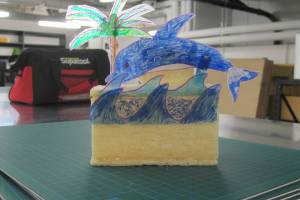Food Automata
This workshop was developed by Peter Musk in 2015 and delivered as a TryIt.
Simple automata using basic machines are created from cheap foodstuffs and hot glue.
summary
Automata are devices with simple moving parts. The movement is usually created by turning a crank. The mechanism driving the motion may be hidden or exposed (as in these examples), and the moving parts are often designed with some artistic elements, with the movement implying a narrative (eg: a simple up and down movement can be used to animate a woodcutter chopping a log).
The advantage of using food as a construction material is that it is cheap and familiar. The disadvantage is that the construction materials are often not uniform, and some physical adjustments are often required for effective actions.
Complete documentation has not been developed, but illustrated workshop guides are available.
workshop materials
Physical materials
Materials and tools required are listed in this document: food_automata_workshop_materials.docx
Stimulus materials
The following file contains several You-Tube clips of modern and ancient automata that were used at the start of the workshop to introduce basic concepts. automata_clips.zip
A powerpoint presentation introducing simple machines was also used: simple_machines.zip
Instructions
Workshop #1

A construction guide for a device which spins (using two perpendicular cogs): edible_automata_construction_guide_1_handout.doc
Workshop #2

A construction guide for a device that rotates, and jumps (usng a cam and follower): edible_automata_construction_guide_2_handout.docx
Workshop #3
 A construction guide for a device that produces a rocking motion (using linkages and an offset push rod): edible_automata_construction_guide_3_handout.doc
A construction guide for a device that produces a rocking motion (using linkages and an offset push rod): edible_automata_construction_guide_3_handout.doc

Evaluation
The first two workshops worked well, but #3 was technically challenging and took much longer that the allocated 2 hours.
Some effort was put to finding an edible glue (Royal Icing was tried, but took too long to harden), but with no success.
Take care to provide skewers that will fit inside the macaroni guides (not all macaroni is the same), and search through your pasta to find relatively straight pieces for best effect.
Cruskits work better than rice crackers (which suffer from too coarse a grain). Less brittle materials also work better when shaping is required (hence the gingernuts).
Food materials may need to be checked for freshness before use - biscuits particularly will become soft through exposure to the air, and will crumble rather than carve.


